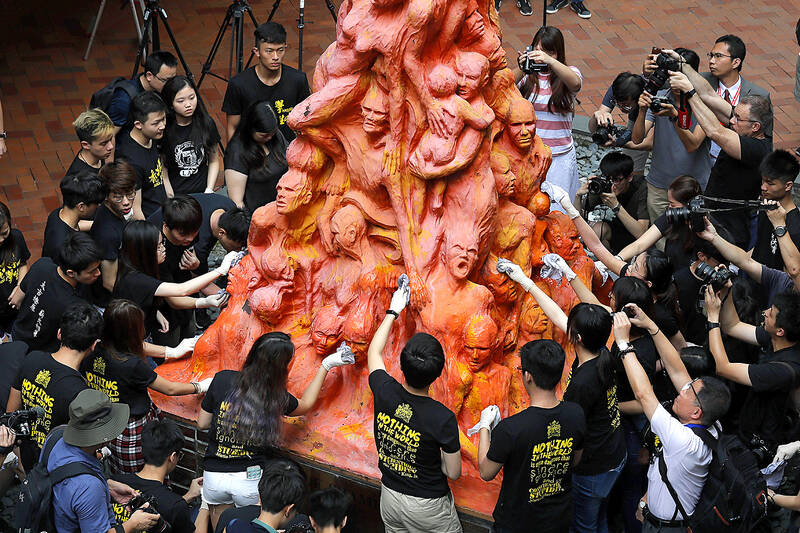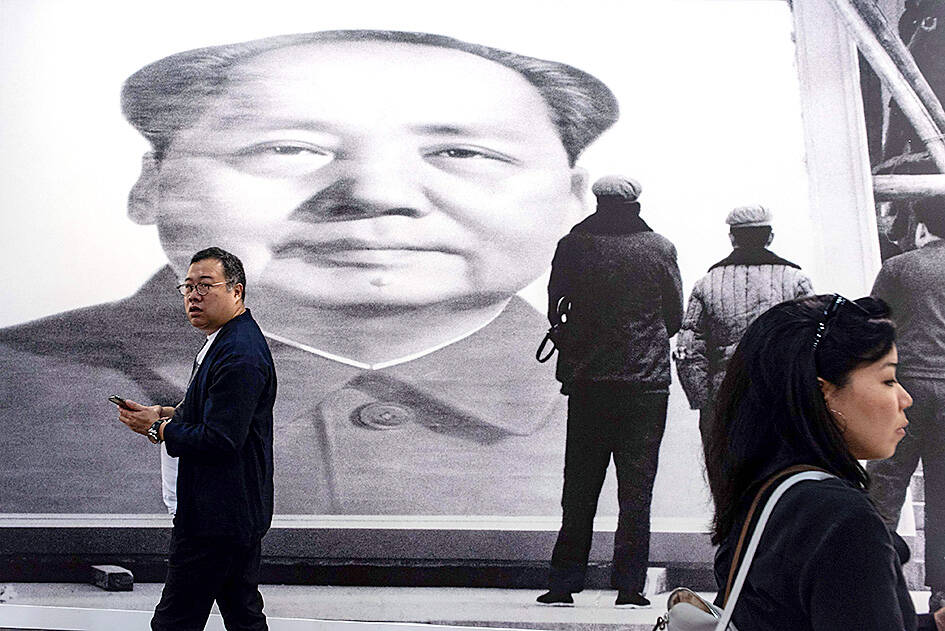From a rocky perch a larger-than-life rendition of a female protester, clad in a hard hat and a gas mask, gazes over a city in turmoil. Known as Lady Liberty Hong Kong, the statue was hauled to the top of Lion Rock during the 2019 pro-democracy protests. It was meant to be her final resting place. But now all that remains of that intention is photographs. The statue was destroyed by unknown assailants the day after it was hauled up the peak, a landmark said to represent the resilient spirit of Hongkongers.
A photograph of Lady Liberty’s brief installation is one of several images relating to Hong Kong to be displayed in The Forbidden Art, an exhibition that opens on Monday in Brussels. Staged outside the EU parliament building, it aims to present a “fervent defense of artistic freedom as a fundamental human right.”
Many of the artists featured no longer feel safe working in Hong Kong.

Photo: AP
“The government wants to silence all of us,” says Lumli, one half of Lumli Lumlong, an artist duo she formed with her husband, Lumlong. The couple left Hong Kong in 2021, fearing for their safety.
“We’re worried that Hong Kong culture will disappear,” Lumlong adds, “but on the other hand it could reappear all over the world.”
The exhibition, organized by Hong Kong-born artist Loretta Lau and Jens Galschiot, a Danish sculptor who made the Pillar of Shame statue that was removed from Hong Kong University in 2021, comes as Hong Kong is trying to cling to its status as a global arts hub, while also grappling with an exodus of artists and increasing calls on international art institutions to boycott the Beijing-controlled territory.

Photo: Reuters
‘I FEEL SORRY FOR THE ARTISTS WHO STAY’
In September, a former president of the Hong Kong chapter of the International Association of Art Critics, Eric Wear, published an open letter calling on galleries to boycott Art Basel’s 2024 Hong Kong art fair, which opens on 28 March.
“Censorship should be rare, with debated safeguards, and never used to support oppressive governments or erase collective memory,” Wear wrote. “Unfortunately, this is not the present situation in Hong Kong.”

Photo: AFP
Overt and implicit limits on artistic expression are becoming increasingly clear. In 2020, after months of pro-democracy protests, Beijing introduced a national security law, which criminalized in broad terms secession, subversion, terrorism and collusion with foreign forces. Chinese authorities say it was necessary to restore stability; critics say the vague wording crushes dissent. More recently, authorities have been talking with increasing frequency about the need to tackle “soft resistance,” a vague term that appears to refer to the use of “media, culture and art” to defy the authorities.
All this has led to opaque or convoluted decisions from artistic venues. In January, the Hong Kong Institute of Contemporary Culture canceled a lease agreement with performing arts group Fire Makes Us Human because of complaints from the education bureau, which cited national security concerns. The following month, M+, a museum of visual culture, removed the name of the film Beijing Bastards, a well-known feature about China’s disillusioned youth, from the credits and brochures of a screening. Explaining the decision, a spokesperson for M+ said: “Regarding the movie mentioned, the film title was updated by film-maker Zhang Yuan (張元) and M+ curatorial team.”
“I feel sorry for artists who stay in Hong Kong,” says Kacey Wong (黃國才), an artist who left for Taiwan in 2021. “Their minds must be spinning so fast. They censor themselves.”
Wong predicts that more artists will leave after a new, homegrown national security law, known as Article 23, is implemented this year. The draft text proposes sentences of up to life in prison for some crimes, including insurrection and treason. A Chinese government spokesperson said Article 23 was necessary for “lasting stability and security in Hong Kong” and that the legislation was “legitimate, lawful and beyond reproach.”
A BOOMING MARKET
With many of Hong Kong’s most outspoken artists either in exile or silenced, commercial institutions are at the heart of a debate about the future of the city’s creative industries.
The government says Hong Kong still has a “vibrant arts and culture community,” touting its share of the global art market as evidence. According to the Art Basel and UBS art market report, China and Hong Kong’s share of the market last year rose to 19 percent, making it the second-largest after the US.
“Hong Kong still has some tremendous advantages over other markets in the region,” says Wear. “The biggest advantage probably is on tax and just generally an environment which makes the movement of goods very smooth.”
The result, according to Wear, is that art institutions “both accept restrictions in Hong Kong and probably increasingly [are] party to exporting those restrictions to other markets.”
A spokesperson for Art Basel said the fair had “never faced any censorship issues at our shows, nor have we been asked to do anything differently since the introduction of the national security law.
“The Hong Kong art scene has grown exponentially since our arrival in 2013 … and our show has become a focal point for the city’s arts community.”
Art Basel Hong Kong 2024 received HK$15m (US$1.9 million) in funding from the government’s mega arts and cultural events fund, which is administered by the culture, sports and tourism bureau. Government funding agreements now routinely include a clause about national security.
An Art Basel spokesperson said: “Our company always abides by the laws and regulations of the jurisdictions in which we operate.”
The comments echo those made by Henry Tang (唐英年), the head of the West Kowloon Cultural District, a cultural hub, when its flagship M+ gallery opened in 2021: “The opening of M+ does not mean that artistic expression is above the law. It is not.”
Today, the museum advertises its collection of Ai Weiwei’s (艾未未) Study of Perspective series, in which the artist holds his middle finger up to various landmarks. But while several photographs in the series are advertised online, the listing for the Tiananmen Square edition, in which Beijing’s central plaza is flipped off by the dissident artist, displays only a gray square with the M+ logo. A museum spokesperson said: “M+ handles its curatorial matters in a professional and independent manner. All of its contents are in full compliance with the laws and regulations of Hong Kong while maintaining the highest level of professional and artistic integrity.”
Defenders of Hong Kong’s art scene point to the fact that even in mainland China’s more restrictive environment, art sells. Political freedom may not be necessary to keep the city’s arts industry afloat, even if in a neutered form. But “people need to be able to reflect on their environment,” says Wear. “Once you begin to hem that in, you lose something. You lose some of the dynamism of the society, you lose the ability to be self-critical as a society … all of this undermines the capacity of a society to evolve.”

Seven hundred job applications. One interview. Marco Mascaro arrived in Taiwan last year with a PhD in engineering physics and years of experience at a European research center. He thought his Gold Card would guarantee him a foothold in Taiwan’s job market. “It’s marketed as if Taiwan really needs you,” the 33-year-old Italian says. “The reality is that companies here don’t really need us.” The Employment Gold Card was designed to fix Taiwan’s labor shortage by offering foreign professionals a combined resident visa and open work permit valid for three years. But for many, like Mascaro, the welcome mat ends at the door. A

If China attacks, will Taiwanese be willing to fight? Analysts of certain types obsess over questions like this, especially military analysts and those with an ax to grind as to whether Taiwan is worth defending, or should be cut loose to appease Beijing. Fellow columnist Michael Turton in “Notes from Central Taiwan: Willing to fight for the homeland” (Nov. 6, page 12) provides a superb analysis of this topic, how it is used and manipulated to political ends and what the underlying data shows. The problem is that most analysis is centered around polling data, which as Turton observes, “many of these

Since Cheng Li-wun (鄭麗文) was elected Chinese Nationalist Party (KMT) chair on Oct. 18, she has become a polarizing figure. Her supporters see her as a firebrand critic of the ruling Democratic Progressive Party (DPP), while others, including some in her own party, have charged that she is Chinese President Xi Jinping’s (習近平) preferred candidate and that her election was possibly supported by the Chinese Communist Party’s (CPP) unit for political warfare and international influence, the “united front.” Indeed, Xi quickly congratulated Cheng upon her election. The 55-year-old former lawmaker and ex-talk show host, who was sworn in on Nov.

Even the most casual followers of Taiwan politics are familiar with the terms pan-blue and pan-green. The terms are used so casually and commonly with the assumption that everyone knows what they mean, that few stop to really question it. The way these terms are used today is far broader and extensive than what they were originally created to represent. Are these still useful shorthand terms, or have people become so obsessed with them that they color perceptions to the point of distortion? LEE TUNG-HUI WAS NO SMURF People often assume that these terms have been around forever, or at least as